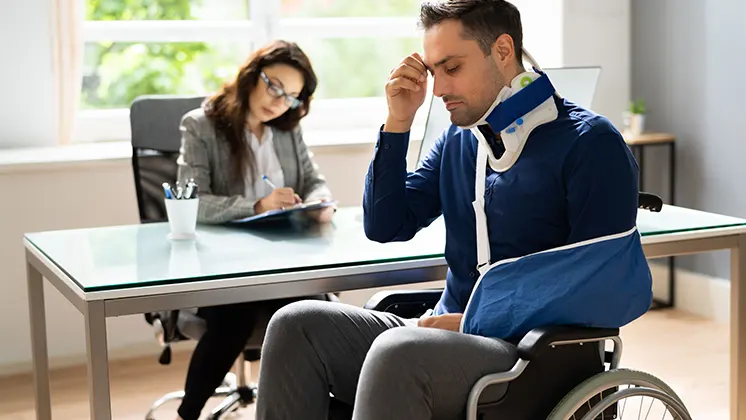What is the Coming and Going Rule for Workers’ Compensation in Virginia?

The coming and going rule is an important concept in Virginia workers’ compensation law. This rule limits the situations in which an injury during an employee’s commute can qualify for workers’ compensation benefits. In this general guide, we explain the coming and going rule in Virginia, including:
- What the coming and going rule is
- The purpose of the coming and going rule
- Exceptions to the coming and going rule
- How to strengthen your claim under the exceptions
- What benefits you may be entitled to.
Understanding these key issues can make all the difference in getting the workers’ compensation benefits you deserve if you are injured while commuting. If you need legal guidance specific to your case, reach out to our experienced workers comp lawyer at Slominski Law. Your consultation is free.
What Exactly is the Coming and Going Rule in Virginia?
The coming and going rule, also called the “going and coming” rule, generally dictates that injuries sustained while traveling to or from work do not qualify for workers’ compensation benefits. Specifically, the coming and going rule in Virginia states that injuries that happen while an employee is on their way to work or on their way home from work are not considered to have arisen “in the course of employment.”
This is an important phrase, because in order to receive workers’ comp benefits under Virginia Code Section 65.2-101, your injury must arise “out of and in the course of the employment.”
Just traveling to and from work generally does not meet the “course of employment” requirement, therefore injuries sustained while commuting are not eligible for workers’ comp. The logic behind this rule is that when employees are traveling, they are responsible for their own means and methods of transportation. The risks involved in commuting are shared by the general public and are not directly related to any specific employment.
However, as we will discuss below, there are some important exceptions that allow for commuting injuries to still receive workers’ compensation benefits.
Why Does Virginia Have This Coming and Going Rule?
The purpose of the coming and going rule in Virginia is to limit the potential liability of employers. Without this rule, employers could be financially responsible for essentially any accident or injury sustained by employees on their way to or from work.
For example, say an employee gets into a major car accident while commuting that leaves them hospitalized for months. Or perhaps an employee slips on ice on the way from the parking lot into the workplace. If the coming and going rule did not exist, these types of accidents could all be eligible for workers’ compensation. Employers would have almost limitless exposure to paying for commute-related incidents. So the rule acts as a way to allocate risk and financial responsibility.
It places the burden of commuting safely on employees rather than employers. This also incentivizes employees to choose reliable transportation and take precautions while traveling.
However, the exceptions to the rule (which we’ll outline below) demonstrate that there are still scenarios where the risks of commuting are intrinsically tied to the employment itself. In these special cases, it makes sense for the employer to bear responsibility.
What are the Exceptions to the Coming and Going Rule in Virginia?
While the coming and going rule limits eligibility for workers’ compensation benefits, Virginia allows three exceptions where commuting accidents can still receive comp:
1. Special Errand or Mission for Employer
If you are injured while carrying out a “special errand” or “special mission” for your employer, your injury may be covered. For example, if your boss asks you to make a delivery or pick up supplies on your way into work, injuries happening on this special trip could qualify you for workers’ compensation.
This exception can be tricky to prove, because it does not apply to your regular duties. So just stopping for coffee for your boss on the way into the office would not count. The errand needs to be a special additional request outside your routine tasks.
2. Paid Travel Time
If your employer pays you for your travel time or provides a vehicle to transport you, any injuries happening during that paid transport can receive workers’ compensation benefits. This makes logical sense because the employer has accepted responsibility for that travel time by paying wages for it. So if they are essentially employing you during the commute, they should bear responsibility for any injuries that happen concurrently.
3. Access to Premises Rule or “Threshold” Exception
This exception covers injuries that happen while you are accessing the work premises or exiting the premises after work. For example, slipping and falling in the company parking lot or on a sidewalk outside the building could qualify you for benefits. The key question here is whether you were injured in an area controlled by the employer or intrinsically linked to accessing the job site. So just being near the workplace does not necessarily count unless you are actively entering or exiting the premises.
Proving the Exceptions to the Coming and Going Rule
As you can see, while Virginia does define these three exceptions to the normal coming and going rule, the exceptions have specific requirements you need to meet to qualify. At Slominski Law, we can help build a strong argument that your injury falls under one of the exceptions. These are examples of evidence we look for:
For the Special Errand Exception:
- Documentation of the specific request made by your employer for you to carry out an unusual errand or delivery on your way to or from work
- Records confirming this was not part of your normal job duties
- Proof that you were injured while directly engaged in this special errand.
For the Paid Travel Time Exception:
- Employment records or pay stubs showing that you were being paid for your travel time when the injury occurred
- Applicable employment policies or handbook sections that describe paid travel time
- Documentation of the amount of wages you receive for travel time.
For the Threshold Exception:
- The precise location of the injury (in the parking lot, on a sidewalk, etc.)
- Diagrams, maps, or layouts showing the area was part of the employer’s premises
- Building lease agreements or property records confirming the employer’s control over the access areas
- Witness statements attesting that you were actively entering or exiting the premises.
Having documentation for elements like these can be vital in showing that your case fits an exception to the coming and going rule. Without it, it becomes much more challenging to argue you qualify for benefits.
What Benefits Can I Claim If My Injury Falls Under an Exception?
If your commuting injury meets one of the exceptions described above, you can make a claim for the same set of workers’ compensation benefits available for other on-the-job injuries:
Medical and Rehabilitation Benefits
This covers the cost of all reasonable and necessary medical treatments related to your injury. That includes hospital fees, medications, surgeries, physical therapy, nursing care, and more. We can help you access top specialists and care facilities.
Temporary Total Disability Benefits
If your injury prevents you from working for a limited time during treatment and recovery, these wage replacement benefits will pay 66 2/3% of your average weekly wages. This maintains some income while you focus on healing.
Permanent Partial or Permanent Total Disability Benefits
For serious injuries that cause permanent impairment or disability, reducing your ability to work long-term, these benefits provide wage supplements to offset lost earning capacity.
Death Benefits
If a commuting injury unfortunately results in a fatality, this provides wage replacement and other compensation to surviving dependents.
The value of these workers’ compensation benefits is immense. Make sure you consult an experienced attorney to determine what exceptions may apply to your commuting accident and what benefits you qualify for.
Why Hire Slominski Law For Help With Your Coming and Going Rule Case?
A claim for a commuting injury involves proving some complex legal and factual issues. It takes an experienced attorney to navigate the exceptions to the coming and going rule.
At Slominski Law, Attorney Jaleh Slominski has over 30 years of dedicated experience representing injury victims in Virginia workers’ compensation cases. She has handled many coming and going exceptions over the years, with proven success in guiding clients through the process to obtain benefits. She takes pride in providing compassionate, personalized counsel to each client.
When our firm takes on a case, we investigate the commuting injury, gather evidence regarding the scene and circumstances, and build a compelling argument around the strongest legal exceptions that apply. We also aggressively pursue the full range of workers’ comp benefits our clients deserve. These often include coordinating medical care, calculating lost wages, and negotiating fair settlements.
To get started today, schedule a free, no-obligation consultation regarding your commuting accident. Contact Slominski Law at (434) 384-9400 (Lynchburg office) or (540) 554-3762 (Roanoke office) or through our online contact form. We look forward to helping you in your workers comp claim.





